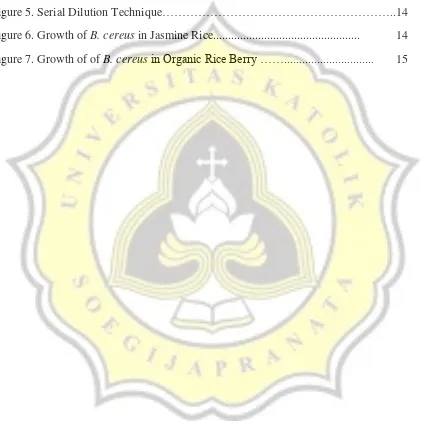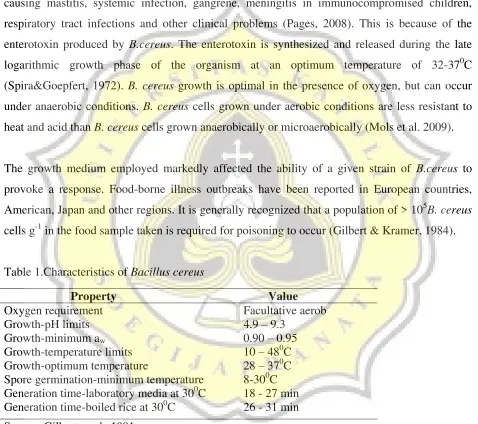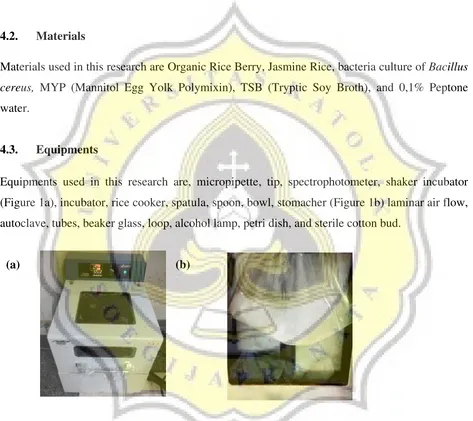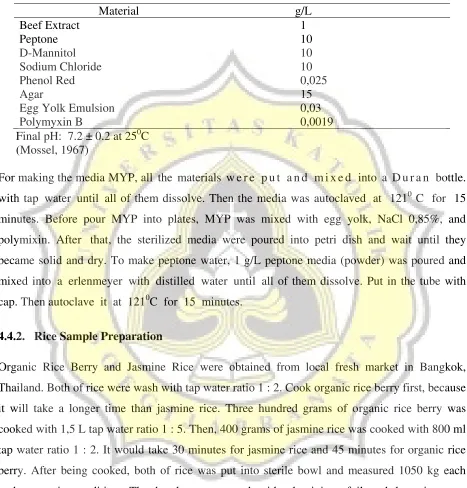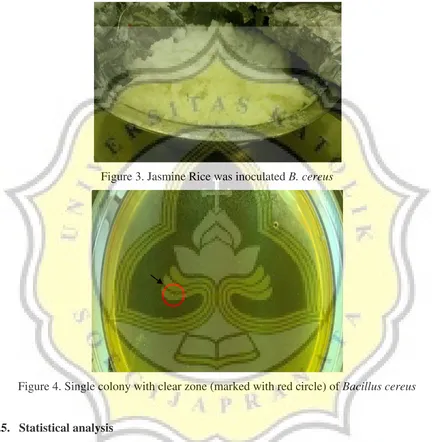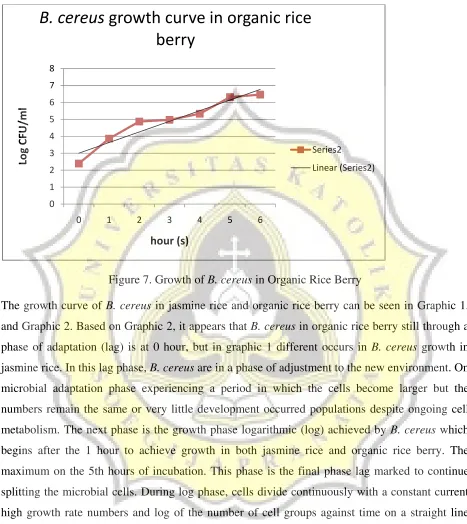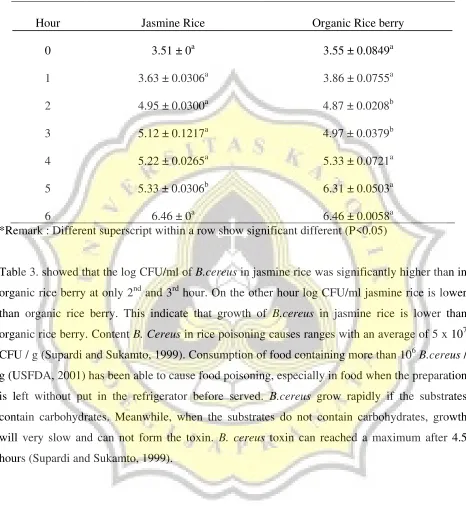Growth Modeling of
Bacillus cereus
in Cooked Rice
PRACTICAL TRAINING REPORT
This practical training report is submitted for the partial requirement for Bachelor Degree
By :
Maria Jessica Arta
12.70.0037
DEPARTMENT OF FOOD TECHNOLOGY
FACULTY OF AGRICULTURAL TECHNOLOGY
SOEGIJAPRANATA CATHOLIC UNIVERSITY
SEMARANG
Growth Modeling of
Bacillus cereus
in Cooked
Rice
“Practical Training at Assumption University, Bangkok, Thailand
By :
Maria Jessica Arta Student ID :12.70.0037 Faculty : Agricultural Technology
Department : Food Technology
This practical training report has been approved and supported by examiner in Practical Training Exam on 12nd June, 2015
Semarang, 4th July 2015
Department of Food Technology Faculty of Agricultural Technology Soegijapranata Catholic University
Technical Advisor Practical Training Advisor
Asst.Prof.Dr. Patchanee Yasurin Dr. Laksmi Hartayanie,M.P
Dean
PREFACE
Praise in the name of Lord Jesus Christ, because only His grace and bless, the author
would have the opportunity to implement the practical training and internship program,
so can finish the report smoothly. During the practical training, the author did the research entitled “Growth Modeling of Bacillus cereus in Cooked Rice”. This report is the complete accountability from the practical training which was done in Assumption
University, Bangkok, Thailand that take place from 16th January to 26th of March, 2015.
The author would not be able to finish all of these tasks alone. The key of success in this
practical training and the report making were caused of the big support and guidance
given the amazed people around the author. There are my special thanks for :
1. My Lord Jesus Christ who is always bless and guide me.
2. Dr. Victoria Kristina Ananingsih, ST., MSc. for giving me this great opportunity to
participate in this internship program.
3. Dr. Patchanee Yasurin as my advisor who was teaching, advising me did this
practical training and for making this report.
4. Dr. Laksmi Hartayanie, M.P for giving me advices for making this practical work
report better.
5. All of Assumption University Biotechnology Department lecturer who are
welcoming and always helping me when I did this research.
6. P’Porn and P’Tuk as a laboratory assistant who always provide stuff and also help
me in the laboratory.
7. Natpisit Chaitachawong as a bachelor senior student who always support,
accompanied, teach me during this research, and also being my partner.
8. My family who is always support and pray for me everyday.
9. Lorentia Santoso, Rr Panulu, Hana Melinda, Buddy Kristianto and William Wibowo
as intership partners who support and accompanied me during this research until
making paper.
10.Last but not least, I would thanks to all my beloved friends who I can’t say it one by
The author realized that this report is still far from perfect and there are still many
shortage due to the limitations of the author. However, the author hoped that this report
can still be an inspiration and provide useful information for all the reader. The author
was very grateful to be able to get a valuable and unforgettable opportunity.
Semarang, 4th July 2015
Maria Jessica Arta
TABLE OF CONTENT
2.3.Vision, Mission, and Strategy of the Faculty……….. 4
2.3.1. Vision……….. 4
4.1. Time and Place of Practical Training………...………..…… 9
7. RECOMMENDATION………. 22 8. REFERENCES………... 23
LIST OF FIGURE
Figure 1. Equipments used : Shaker Incubator (a) and Stomacher (b)... 9
Figure 2. Working culture overnight (Bacillus cereus) with 0,1 OD600...11
Figure 3. Inoculated Jasmine Rice... 12
Figure 4. Single colony (marked with red circle) of B.cereus... 12
Figure 5. Serial Dilution Technique……….. 14
Figure 6. Growth of B. cereus in Jasmine Rice... 14
LIST OF TABLE
Table 1. Characteristics of Bacillus cereus……… 8
Table 2. Composition of MYP Media………..10
Table 3. Mean and SD of B.cereus in Jasmine rice and Organic Rice Berry up to six hour………...16
1
INDEX OF APPENDICES
Appendix 1. Map of Assumption University, Hua Mak, Bangkok………... 25
2
many problem related with food, such as food crisis problem that caused hunger, food
disease, food safety, agricultural problem and also food waste problem. Besides the
primary demand, as the development of science and technology, the demand of food
becoming more complex and diverse like simplicity of serving, good appearance and
more importantly, the ability to promote health. Therefore, food technology has the very
important role for answering the changing demand of food products which always
increasing day by day.
The practical training for students of Food Technology Department from Soegijapranata
Catholic University in Faculty of Biotechnology, Assumption University, Thailand has
become one of the ways to participate in overcoming the food problem. During this
practical training, students from Soegijapranata Catholic University have a duty of
learning new knowledge in their own research. And this practical training will give the
student more capability in research, so the student can do something to overcoming the
food problem. This program has a purpose to fit up the students with the food-related
research or the experience in real world practice of food industry, either in food
industries or food technology related institutions for developing skills and experience in
order to face the opportunities and challenges in food technology development. Students
are also encouraged to get a new experience either in food industries or food technology
related institutions. Faculty of Biotechnology, Assumption University, Thailand has
become a great partner of Food Technology Department, Soegijapranata Catholic
University since 2007. Advance technology and facility in Biotechnology and
3
Catholic University to take part in internship program with Assumption University.
Furthermore, this practical training in Thailand will give a new experience living
abroad, chance to meet people from other countries, get new friend and connection, and
learn to respect culture diversity in this globalization era. Therefore, this internship
program will give lot of benefit to the student, faculty and the society in the future.
1.2. Purpose of Practical Training
a. To give the student an experience to conduct about food research in abroad, so that
the student can implement the knowledge that they learned in the real industrial or
scientist world.
b. The student gets a better insight in the practical aspects of the laboratory.
c. To give the student an opportunity to adapt with new circumstances and society.
d. To strengthen relationship between Soegijapranata Catholic University and
Assumption University is noted for attracting large numbers of foreign students from
countries including Russia, China, Myanmar, India, Bangladesh, Pakistan, Malaysia,
and other Asian countries. Students from China make up the largest number of foreign
students, with up to 6,000 enrolled. Approximately 1,001 Indian students also attend the
university. There are exchange students from the United States (Loyola) and Europe.
Assumption University is also the first international university in Thailand. Assumption
University became an autonomous educational institution in 1969 when Assumption
Commercial College (ACC) originated Assumption School of Business. In 1972 it
became Assumption Business Administration College (ABAC). In 1990 the college was
granted a university status by the Ministry of University Affairs and took the name of
Assumption University (AU). Recently, AU has been expanding the Suvarnabhumi
campus with Gothic-style buildings and creating a nature-centered atmosphere it calls
the "University in the Park".
Assumption University offers many majors, such as Engineering, Information
Technology, Science, Nursing, Law, Business Administration, Communication Art,
Architecture, Biotechnology and Music. It is also the leading provider of E-learning in
Thailand since it has established the College of Internet Distance Education on
December 21, 2002.
2.2. Faculty of Biotechnology
The Faculty of Biotechnology was founded 1993 as the ninth faculty in Assumption
University to produce graduates working in biotechnology field and its related fields.
The faculty has been offering two 4-year bachelor’s programs in Agro Biotechnology
5
the Ministry of University Affairs in 1997. Since then the Faculty has produced 4
classes of graduate with the degree of BS in Agro-Industry and in Food Technology, to
the country. The majorities of the Thai people are involved in agriculture and related
industries. Knowledge in biotechnology can be directly implied to the utilization of
agricultural products to increase the value. Therefore, it has a big impact on the living of
most Thais. Biotechnology can provide agriculture with a variety of useful agents, from
soil inoculants to veterinary products and possibly aqua-cultural and marine cultural
products. Biotechnology implementation begins with the supplement of traditional
genetic methods for the development of new or improved plant and animal strains for
conventional agriculture. It also provides the food industry with bio-process and food
ingredients like starter culture and enzyme, which directly involved in food processing.
Main administrators of the faculty member and all the 19 full-time instructors, three
teaching assistants, one administrative staff and two laboratory technicians.
2.3. Vision and Mission, and Strategies of Faculty
In line with the university’s philosophy of education, the Faculty of Biotechnology has adopted the following vision, missions and strategies.
2.3.1. Vision
The application of life sciences to industrial processes yielding products and services
that ultimately benefit the consumers through bio-resources and technology.
2.3.2. Mission
1. To provide the nation with highly trained professionals who are able to apply basic
and applied scientific principles to continuous improvement of the safety, quality
and value of biotechnological services and products.
2. To produce graduates characterized by moral and ethical principles
3. To produce graduates who are competent to pursue advanced studies in fields
6
2.3.3. Strategy
Thailand is a major producer of agricultural commodities used in bioprocessing and a
significant food manufacturing sector. However, the food manufacturing lags behind the
international average in the amount of value added in processing. Experience and
state-of-the-art faculty members available in bioprocessing and technology development
uniquely qualify the faculty of Biotechnology to play a major role in addressing these
opportunities. The purpose of the faculty is to facilitate expansion of programs in
bioprocessing, foster development of multidisciplinary efforts and encourage excellence
in scientific research and academic program with the assistance of information
6
3. RESEARCH PROJECT
3.1. Research Overview
The main topic of the research was “The Growth Modeling of Bacillus cereus in Cooked Rice”. The objective of this research was to see the growth model of Bacillus cereus in Organic Rice Berry and Jasmine Rice by using Total Plate Count method. This experiment was done from zero
hour and every 1 hour after inoculation up to 6 hour at incubated temperature of Bacillus cereus.
3.2. Background of Research
Foodborne diseases caused by pathogenic bacteria are still a major threat to public health. B. cereus is responsible for the majority of foodborne illness attributed to Bacillus. During 1993-1997, B. cereus was linked to 14 outbreaks and caused 691 reported cases of foodborne illness in the United States (Keith et al., 2004). B. cereus is a Gram-positive, mobile, facultative and aerobic spore former. In fact, 19 of 22 strains of B. cereus is produce enterotoxin which is known as diarrheagenic toxin, diarrheal agent, fluid accumulation factor, vascular permeability factor,
dermonecrotic toxin and intestinonecrotic toxin (Spira and Goepfert, 1972).
Bacillus cereus is often present as an intrinsic contaminating microorganism in Refrigerated Processed Foods of Extended Durability (REPFED), pasteurized milk, rice dishes and pastas.
During shelf life it may become a major part of the microflora. Because of its resistant spores,
significant numbers of B. cereus have also been found in herbs and spices, vegetables and dehydrated foods. The presence of both vegetative cells and spores in food commodities has
been reported and their role in food safety and food spoilage elaborated (Priest, 1993).
The main goal of any microbiological treatment is to improve food quality and extend shelf life.
The safety and shelf life of many food products is dictated by the time and/or temperature
required for pathogenic or spoilage microorganisms to reach a critical level (O’Brien, 1996).
Thus, models are essential tools for helping assess and manage risk to human illness from food.
Microbial modeling can predict pathogen behavior under conditions for which no data exist.
8
focused on the control and suppression of B. cereus contamination in rice (Kim, 2013). Still fewer studies directed at rice microbiological risk assessment have focused primarily on
prediction of B. cereus growth, especially that of spores during storage. Because the spores can survive extreme temperatures, when conditions allow they will germinate in contaminated food
and multiply relatively slowly. B. cereus vegetative cells also can grow and produce enterotoxins over a wide range of temperatures from 25 to 42°C. Most studies investigating the growth of B.
cereus on rice have employed spores under nonstress conditions (Heo, 2009).
Rice is a daily meal for people in the Asia–Pacific region. It is believed to provide more health benefits than other carbohydrate based foods, since it contains several nutrients and anti-oxidative compounds. Thai rice, especially, has gained popularity world wide for its nutrients
and fragrance. Rice bran is a by-product from rice milling. This variety has a crunchy texture and
is used in desserts and salads. The bran is naturally black (purple) and on cooking releases a
purple color. Riceberry, a Thai black rice, has been recently developed with the aim of providing optimum nutritional benefit to general consumers, as well as supplementation to anaemic and diabetes mellitus patients, since it contains high iron and low glucose. The bran part of Riceberry
is believed to be high in antioxidants and other significant constituents, such as anthocyanins,
etc., that possess chemopreventive properties (Leardkamolkarn et al., 2010).
Jasmine rice, called Hom Mali or KDML 105 (Khao Dawk Mali), originates from the Isaan
region in northeastern Thailand. Released in 1959, Hom Mali was developed during the 1980s
through a governmental initiative for export purposes. Jasmine rice cropping increased by 74%
from 1990 to 1998, reaching 28.3% of rice overall acreage in Thailand, despite low yields
varying from 1.9 to 2.3 tons per hectare (T/ha) (Rahman et al. 2009). Khao Dawk Mali (KDML)
105 is one of the most popular rice varieties in Thailand. In Thailand, Jasmine rice is considered
as a vital crop for domestic consumers and a primary export commodity for economic growth
(Sarkarung, Somrith, & Chitrakorn, 2000; Chitrakorn, 2003). Jasmine rice can be consumed in
many ways, for example whole grain consumption. Some Asian peoples cook their rice in an
ample amount of water to obtain desirable texture whereas, in many western cultures, rice is
9
3.2.1. Bacillus cereus
Bacillus cereus is a gram-positive, facultative aerobic rod shaped endospore-forming bacterium. Other characteristics are listed in Table 1. B. cereus has a wide distribution in nature, frequently isolated from soil and growing plants, but it is also well adapted for growth in the intestinal tract
of insect and mammals. In addition to causing foodborne illness, B. cereus is also capable of causing mastitis, systemic infection, gangrene, meningitis in immunocompromised children,
respiratory tract infections and other clinical problems (Pages, 2008). This is because of the
enterotoxin produced by B.cereus. The enterotoxin is synthesized and released during the late logarithmic growth phase of the organism at an optimum temperature of 32-370C
(Spira&Goepfert, 1972). B. cereus growth is optimal in the presence of oxygen, but can occur under anaerobic conditions. B. cereus cells grown under aerobic conditions are less resistant to heat and acid than B. cereus cells grown anaerobically or microaerobically (Mols et al. 2009).
The growth medium employed markedly affected the ability of a given strain of B.cereus to provoke a response. Food-borne illness outbreaks have been reported in European countries,
American, Japan and other regions. It is generally recognized that a population of > 105B. cereus
cells g-1 in the food sample taken is required for poisoning to occur (Gilbert & Kramer, 1984).
10
4. RESEARCH METHODOLOGY
4.1. Time and Place of Practical Training
The practical training is conducted in the Microbiology Laboratory of Biotechnology Faculty,
Assumption University HuaMak Campus, Bangkok, Thailand, and take place from January, 16th
to March, 26th 2015.
4.2. Materials
Materials used in this research areOrganic Rice Berry, Jasmine Rice, bacteria culture of Bacillus cereus, MYP (Mannitol Egg Yolk Polymixin), TSB (Tryptic Soy Broth), and 0,1% Peptone water.
4.3. Equipments
Equipments used in this research are, micropipette, tip, spectrophotometer, shaker incubator
(Figure 1a), incubator, rice cooker, spatula, spoon, bowl, stomacher (Figure 1b) laminar air flow,
autoclave, tubes, beaker glass, loop, alcohol lamp, petri dish, and sterile cotton bud.
(a) (b)
Figure 1. Equipments used : Shaker Incubator (a) and Stomacher (b)
4.4. Methods
11
Thailand. Both of rice were wash with tap water ratio 1 : 2. Cook organic rice berry first, because
it will take a longer time than jasmine rice. Three hundred grams of organic rice berry was
cooked with 1,5 L tap water ratio 1 : 5. Then, 400 grams of jasmine rice was cooked with 800 ml
tap water ratio 1 : 2. It would take 30 minutes for jasmine rice and 45 minutes for organic rice
berry. After being cooked, both of rice was put into sterile bowl and measured 1050 kg each
under aseptic condition. The bowl was covered with aluminium foil and kept in room
temperature during process.
12
Culture preparation Biotechnology Faculty, Assumption University’s Stock culture of B. cereus
were prepared by inoculating one loopful of culture into 10 mL fresh Tryptic Soy Broth (TSB)
and shake overnight by shaker incubator. Shaker incubator used to make aeration condition as
Lawley (2008) said that B. cereus grow on a medium containing oxygen (aerobic) that is also known by the term aerobic sporeformers although they can grow under facultative aerobic
condition. Most members of the genus Bacillus can form endospores formed intracellularly in response to unfavorable environmental conditions. Therefore, members of the genus Bacillus
have a high tolerance to environmental conditions change. Then 1% v/v of overnight culture was
inoculated into 40 mL of fresh TSB and shake for 100 rpm, until optical density at 600 nm reach
0.1 (SPECTRONIC, model GENESYS 5) which is in their early log phase. After this, 11 ml of
culture was taken by micropipette (1% v/v of overnight culture from 1050 kilograms samples)
and put on rice samples in the sterile bowl covered with aluminium foil, samples were mixed
well while the culture was added.
Figure 2. Working culture overnight (Bacillus cereus) with OD600 is reached 0,1
4.4.4. Bacteria Growth Determination
Rice samples were taken and measured 25 grams each hour, then 225 ml 0,1% peptone water
was poured into plastic bag sample under aseptic condition. Stomacher was used to smashed rice
and then dissolved by peptone. The bacteria growth on the samples were carried out by spread
plate method. In this method, TSB were used as culture media. Before do spread plate, serial
dilution technique there are 10-1, 10-2, and 10-3 has done, where 10-1 dilution is rice sample and
13
plastic bag and were incubated at 370C for 24 hours. Number of colony was counted by colony
counter (Stuart Scientific). This experiment was done from zero hour and every 1 hour after
inoculation up to 6 hours and were repeated 3 times with duplicate plates.
Figure 3. Jasmine Rice was inoculated B. cereus
Figure 4. Single colony with clear zone (marked with red circle) of Bacillus cereus
4.4.5. Statistical analysis
The experiment was done in three replications independently. The t-test multiple comparison
Duncan has been done by using R-statistic to study the growth model of B. cereus in cooked rice.
14
5. RESULTS AND DISCUSSION
In this research, rice samples were prepared first. Organic Rice Berry and Jasmine Rice were
were washed with tap water ratio 1 : 2. Three hundred grams of organic rice berry was cooked
with 1,5 L tap water ratio 1 : 5. Then, 400 grams of jasmine rice was cooked with 800 ml tap
water ratio 1 : 2. It would take 30 minutes for jasmine rice and 45 minutes for organic rice berry.
After being cooked, both of rice was put into sterile bowl and measured 1050 kg each under
aseptic condition. The bowl was covered with aluminium foil and kept in room temperature
during process.Organic rice berry should be cooked first, because it will take a longer time than
jasmine rice. Rice containing high amylose produce dry rice product, otherwise the rice
containing low amylose produce sticky rice and soft. Amylose content related to the amount of
water absorption and development of the volume of rice during cooking. The higher the amylose
content, the less sticky rice and the harder (Juliano, 1982). Furthermore, proposed by Haryadi
(2008), rice containing higher protein requires more water and a longer cooking time. This
relates to the structure of the seed, which is enclosed in a starch granule protein that blocks the
absorption of water by the protein starch granules, and resulted in more length of time required
for cooking so that gelatinization can take place perfectly. In addition, high-protein rice produce
flavorful less tasty.
The Standard Total Plate Count is the most common method used to quantify bacteria in foods.
To perform a standard plate count, the food to be tested is suspended in liquid and a sample is
then spread over the surface of a solid medium in a petri dish. Bacterial cells present will form
colonies that can be counted to determine the number of cells in the original sample. When the
objective is to estimate the total number of bacteria, a complex medium called Plate Count Agar
is commonly used since it will support growth of many different types of bacteria. We call the
results the number of Colony Forming Units (CFU), not total bacteria. This is because no single
culture medium will support all different types of bacteria, we can only count those that do grow
to form a visible colony (Hocking, 2003).
Serial dilution technique used in this study. The serial dilution technique done by find the one
15
method. Spread plates, also known as lawn plates, the culture spread evenly over the surface of
the growth medium. The spread plate can be used for quantitative work (colony counts) if the
inoculum is a measured volume (Kiiyukia, 2003). In the spread plate method, 0,1 ml of diluted
sample is pipetted onto the surface of a solidified agar medium and spread with a sterilized glass
rod. Sterile spreaders are used to distribute inoculum over the surface of agar medium in plates.
16
Figure 7. Growth of B. cereus in Organic Rice Berry
The growth curve of B. cereus in jasmine rice and organic rice berry can be seen in Graphic 1. and Graphic 2. Based on Graphic 2, it appears that B. cereus in organic rice berry still through a phase of adaptation (lag) is at 0 hour, but in graphic 1 different occurs in B. cereus growth in jasmine rice. In this lag phase, B. cereus are in a phase of adjustment to the new environment. On microbial adaptation phase experiencing a period in which the cells become larger but the
numbers remain the same or very little development occurred populations despite ongoing cell
metabolism. The next phase is the growth phase logarithmic (log) achieved by B. cereus which begins after the 1 hour to achieve growth in both jasmine rice and organic rice berry. The
maximum on the 5th hours of incubation. This phase is the final phase lag marked to continue
splitting the microbial cells. During log phase, cells divide continuously with a constant current
high growth rate numbers and log of the number of cell groups against time on a straight line
(Shantharam, 1997 in Nurhajati et al., 2009). Bacillus cereus stationary phase on jasmine rice has longer time than organic rice berry which look began after the 2 hours up to 5 hours of
incubation, whereas in organic rice berry look began 2 and 3 hours.
0
B. cereus
growth curve in organic rice
berry
Series2
17
Table 3. The Growth of B.cereus (log CFU/ml) in Jasmine rice and Organic Rice Berry up to six hour.
Hour Jasmine Rice Organic Rice berry
0 3.51 ± 0a 3.55 ± 0.0849a
1 3.63 ± 0.0306a 3.86 ± 0.0755a
2 4.95 ± 0.0300a 4.87 ± 0.0208b
3 5.12 ± 0.1217a 4.97 ± 0.0379b
4 5.22 ± 0.0265a 5.33 ± 0.0721a
5 5.33 ± 0.0306b 6.31 ± 0.0503a
6 6.46 ± 0a 6.46 ± 0.0058a
*Remark : Different superscript within a row show significant different (P<0.05)
Table 3. showed that the log CFU/ml of B.cereus in jasmine rice was significantly higher than in organic rice berry at only 2nd and 3rd hour. On the other hour log CFU/ml jasmine rice is lower
than organic rice berry. This indicate that growth of B.cereus in jasmine rice is lower than organic rice berry. Content B. Cereus in rice poisoning causes ranges with an average of 5 x 107 CFU / g (Supardi and Sukamto, 1999). Consumption of food containing more than 106B.cereus / g (USFDA, 2001) has been able to cause food poisoning, especially in food when the preparation
is left without put in the refrigerator before served. B.cereus grow rapidly if the substrates contain carbohydrates. Meanwhile, when the substrates do not contain carbohydrates, growth
18
Table 4. Comparison of specific growth rate of B.cereus in Jasmine rice and Organic Rice Berry.
Spesific growth rate (hr-1)
Replication 1 Replication 2 Replication3 Average SD
Jasmine Rice 0.36 0.34 0.33 0.34b 0.0153
(Balasubramanian and Bell, 2003). On the other hand, non-organic rice in this case jasmine rice,
does not use organic materials in any eradication of pests, they use chemical compound on
pesticide. That is why B. cereus growth in jasmine rice take longer time than organic rice berry. Pesticide in jasmine rice still stricken and inhibit B. cereus to grow, even though the rice is cooked.
Bacillus cereus is a food-poisoning bacterium that may cause two types of gastrointestinal disorders: the emetic syndrome, caused by ingestion of a preformed toxin in the food, and the
diarrhoeal syndrome, caused by a different toxin that can be formed in the food but also in the
small intestine (Granum and Lund, 1997; Granum, 2001). Due to its ubiquitous distribution in
nature, B. cereus occurs frequently in a wide range of food raw materials. Rice-based products and farinaceous foods such as pasta and noodles are frequently contaminated and involved in B.
cereus poisoning (Kramer and Gilbert, 1989). Levels of B. cereus greater than 103 cfu/g have been found in both cooked and uncooked rice and in cereal products all over the world. Natural
antimicrobial substances, such as bacteriocins, are being investigated for food preservation and
to replace chemical preservatives (Cleveland et al., 2001), although nisin is currently the only
bacteriocin widely used (Thomas et al., 2000). Some bacteriocins, such as nisin or lacticin 3147,
19
There are two types of B. cereus food poisoning. The first type, caused by an emetic toxin, results in vomiting, while the second type, caused by enterotoxins, gives diarrhoea (Kramer,
1989). In a small number of cases both types of symptoms are recorded , probably due to
production of both types of toxins. Although the enterotoxins can be preformed, the number of B. cereus cells in the food would be at least two orders of magnitude higher than that necessary for causing food poisoning, and such products would no longer be acceptable to the consumer
(Granum, 2001).
The emetic toxin causes emesis (vomiting) only and its structure has for a long time been a
mystery, as the only detection system involved living primates (Kramer, 1989). The emetic toxin
is resistant to heat, pH and proteolysis but is not antigenic. It is not clear if the toxin is a modified
gene product or if it is enzymatically produced through modification of components in the
growth medium. However, with such a structure it is most likely that cereulide is an
enzymatically synthesised peptide and not a genetic product.
Bacillus cereus is ubiquitously present in soil, vegetation water and dust. It has been isolated from a large variety of foods, including vegetables, meat, cereals, pasteurized fresh milk and
powdered milk and processed foods. Under favourable conditions, the organism multiplies and
causes gastrointestinal illness. It is implicated in two different forms of food poisoning; an
emetic illness and a diarrhoeal illness. The emetic illness is mediated by a highly stable toxin that
survives high temperature, exposure to trypsin, pepsin and pH extremes. The diarrhoeal illness is
mediated by a heat and acid labile enterotoxin. Lecithinase activity is the key reaction in the
differential identification of B.cereus, the most commonly encountered and important species in clinical laboratories, from the majority of the other Bacillus species (Bergdoll, 1981). If
unknown isolate produceslecithinase, Bacillus cereus can be presumptively identified by also
observing colonial morphology, hemolytic reactivity and motility tests. In 1967, Mossel et al
formulated Mannitol-Egg Yolk-Polymyxin (MYP) Agar, which is recommended by APHA to
20
polymyxin B. When present in large numbers in certain foodstuffs, B.cereus can produce
metabolites responsible for the clinical symptoms of food poisoning. This medium differentiates
B.cereus from other bacteria based on the basis of lecithinase activity, mannitol fermentation and resistance to polymyxin (Rhodehamel, 1995).
MYP Agar contains peptic digest of animal tissue and meat extract, which provide nitrogen
source. Mannitol fermentation can be detected by phenol red, which yields yellow colour to the
mannitol fermenting colonies due to acid production. Added egg yolk emulsion helps in
differentiation of lecithinase producing colonies, which are surrounded by a zone of white
precipitate. Addition of Polymyxin B Sulphate (FD003)used to inhibit accompanying microflora
when the tested sample is heavily contaminated and helps to restrict growth of gram-negative
bacteria such as Escherichia coli and Pseudomonas aeruginosa. These differentiating media allow differentiation of B.cereus from other Bacillus species by its inability to ferment mannitol and poor sporulation. B.cereus dissimilates egg yolk and gives rise to typical bacilli form colonies. MYP used as selective media which are designed to suppress the growth of unwanted
bacteria and encourage the growth of the desired microorganisms. Antibiotics, high
concentrations of salt, or high acidity might be used.MYP Agar could be storage at 6 – 12°C and
have shelf life 14 weeks.
Beef Extract and Peptone provide nitrogen, vitamins, minerals and amino acids essential for
growth. Mannitol is the fermentable carbohydrate providing carbon and energy, Bacillus cereus
is mannitol-negative. The Mannitol content allows the identification of the accompanying
mannitol positive flora, which are characterized by a yellow color. Phenol red is the pH
indicator. Bacteriological agar is the solidifying agent. Bacillus cereus is resistant to certain concentrations of Polymyxin, which inhibits the accompanying flora. Bacillus cereus produces lecithinases. The insoluble degradation products of the lecithin of egg yolk accumulate around
21
6. CONCLUSION
22
7. RECOMMENDATION
Bacillus cereus has traits and characteristics that could be used and further investigated during growth such as, pH, water activity. This research only analyze modeling growth of B. cereus
without concern more intrinsic and extrinsic factors. Therefore, this result is not strong enough
because different result may due to different condition such as human error. It would be better to
analyze pH, temperature, and water activity on next research which has similar topic and sample
23
8. REFERENCES
Balasubramanian, Vand M. Bell.2003. Organic Materials and Manures. Rice science for Better World. International Rice Research Institute (IRRI). December 04, 2003.
Bergdoll M. S., 1981, Clin. Microbiol. Newsletter 3: 85-87.
Cleveland, J., Montville, T.J., Nes, I.F., Chikindas, M.L., 2001. Bacteriocins: safe, natural antimicrobials for food preservation. International Journal of Food Microbiology 71, 1– 20.
Gilbert, RJ., Turnbull, PCB, Parry, JM., and Kramer, JM. 1981. Bacillus secerus and other Bacillus species: their part in food poisoning and other clinical infections. InThe aetobic endospore-forming bacteria:classification and identification. (edBarkeley, R.C.w and Goodfellow, M.), Academic Press,London pp. 297-314.
Granum, P.E. (1997) Bacillus cereus. In: Fundamentals in Food Microbiology (Doyle M., Beuchat, L. and Montville, T., Eds.), pp. 327–336. ASM Press, Washington, DC.
Granum, P.E., 2001. Bacillus cereus. In: Doyle, M.P., Beuchat, L.R., Montville, T.J. (Eds.), Food Microbiology. Fundamentals and Applications, (2nd edition). ASM Press, Washington, DC, pp. 373–381.
Heo, S. K., J. Y. Lee, S. B. Baek, and S. D. Ha. 2009. A response surface model to describe the effect of temperature and pH on the growth of Bacillus cereus in cooked rice. J. Food Prot. 72:12961300.
Hocking, A.D (ed.) (2003). Foodborne Microorganisms of Public Health Significance (6th edition). Waterloo: Australian Institute of Food Science and Technology.
Jaquette, C.B., Beuchat, L.R., 1998. Combined effects of pH, nisin, and temperature in growth and survival of psychrotrophic Bacillus cereus. Journal of Food Protection 61, 563– 570.
Juliano, B. O. (1982). An international survey of methods used for evaluation of the cooking and eating qualities of milled rice. IRRI Research Paper Series, 77, 1–28.
Kramer, J.M. and Gilbert, R.J. (1989) Bacillus cereus and other Bacillus species. In: Foodborne Bacterial Pathogens (Doyle, M.P., Ed.), pp. 21–70. Marcel Dekker, New York.
Keith, RS., Mickey, EP., Renee, MG., and Taylor, C. 2004. Preventing Foodborne illness : Bacillus cereus and Bacillus anthracis. Series of the Food Science and Human Nutrition Department discussion. Institute of Food and Agricultural Science, University of Florida.
24
Kim, S. A., Lee, M. K., Park, T. H., and M. S. Rhee. 2013. A combined intervention using fermented ethanol and supercritical carbon dioxide to control Bacillus cereus and Bacillus subtilis in rice. Food Control 32:93-98.
Lawley, Richard; Curtis, Laurie, and Judy Davis. 2008. The Food Safety Hazard Guidebook. RSC Publishing.
Leardkamolkarn Vijittra, Wirangrong Thongthep, Panawan Suttiarporn, Ratchanee Kongkachuichai, Sugunya Wongpornchai, Apichart Wanavijitr. 2010. Chemopreventive properties of the bran extracted from a newly-developed Thai rice: The Riceberry.
Mols M, Pier I, Zwietering MH, Abee Tj (2009) The impact of oxygen availability on stress survival and radical formation of Bacillus cereus. International Journal of Food
Microbiology 135(3):303–311
Mossel, D.A.A., Koopman, M.J., and Jongerius, E. 1967. Enumeration of Bacillus cereus in Foods. App. Microb., 15, (3): 650-653.
Nurhajati, J.S., R. Sulistijowati., dan I. Amaliah. 2009. The Influence of Giving Various Concentrations and Method of Inoculum Lactobacillus acidophilus According to Immersion Time for Total Escherichia coli in Swordfish Stew (Auxis rochei). International SeminarBiotechnology. Unpad. Bandung.
O'Brien, J. K., and R. T. Marshall. 1996. Microbiological quality of raw ground chicken processed at highisostatic pressure. J. Food Prot. 59:146-150.
Pages, JM., C.E. James., M. Winterhalter. 2008. The porin and the permeating antibiotic: A selective diffusion barrier in gram-negative bacteria. Nat. rev. Microbiol, Vol 6:893-903.
Priest, F.G. 1993. Systematics and ecology of Bacillus. In: Sonenshein AL, Hoch J, Losick R (eds) Bacillus subtilis and other gram positive bacteris, biochemistry, physiology and molecular genetics. American Society for Microbiology Press. Washington. DC.
Rahman, S., A. Wiboonpongse, S. Sriboonchitta and Y. Chaovanapoonphol. 2009. Production Efficiency of Jasmine Rice Producers in Northern and North-Eastern Thailand. Journal of Agricultural Economics 60(2): 419-435.
Rhodehamel J. and Harmon S. M., 1995, FDA Bacteriological Analytical Manual, 8th Ed., AOAC International, Gaithersburg, Md.
Sarkarung, S., Somrith, B., & Chitrakorn, S. (2000). Aromatic rice of Thailand. In R. K. Singh, U. S. Singh, & G. S. Khush (Eds.), Aromatic rices (pp. 180–183). New Hampshire: Science Publishers.
25
Spira, WM., Goepfert, JM. 1972. Bacillus cereus-induced fluid accumulation in rabbit ileal loops. Appl. Microbiol,Vol 24:341-348.
Thomas, L.V., Clarkson, M.R., Delves-Broughton, J., 2000. Nisin. In: Naidu, A.S. (Ed.), Natural Food Antimicrobial Systems. CRC Press, Boca Raton, FL, pp. 463– 524.
26
9. APPENDICES
Appendix 1. Map of Assumption University, HuaMak, Bangkok
Appendix 2. Research Project Schedule
January February March April May June Note
1 2 3 4 1 2 3 4 1 2 3 4 1 2 3 4 1 2 3 4 1 2 Week
Reference
searching
Pre-research
Research
Report
